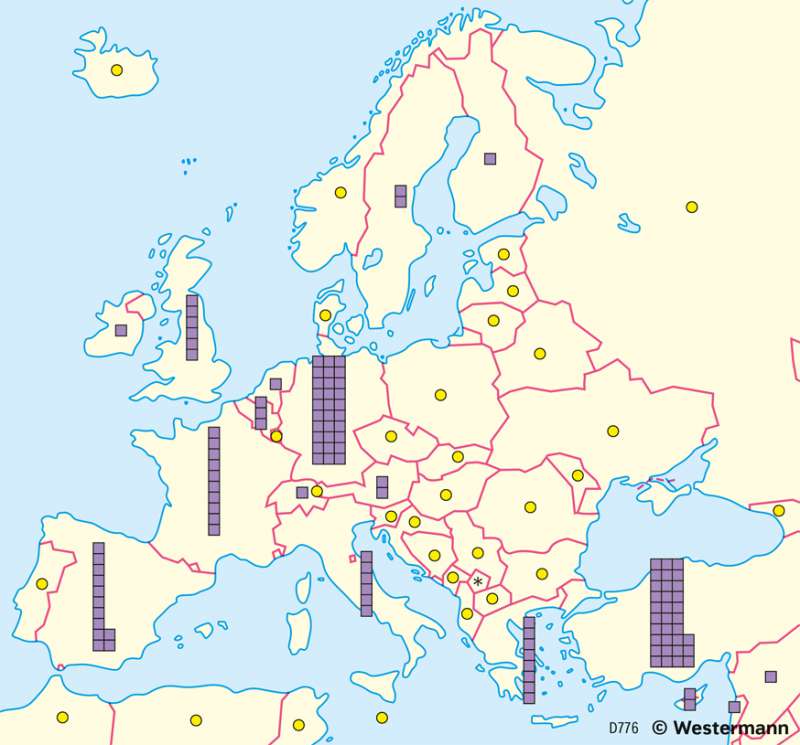Europe - Asylum seekers
Population and migration
978-3-14-100890-6 | Page 69 | Ill. 7

Overview
The causes of migration are very often situations of persecution, for example for political, religious or ethnic reasons or because of existentially threatening oppression based on gender. Asylum seekers are refugees who have been accepted in other countries and for whom it is currently being examined whether they are entitled to political asylum and a right to stay there because of such reasons of persecution. The right to asylum is a widely recognised fundamental right.
Asylum as a political issue
In political reality, however, numerous areas of conflict arise, and in many cases attempts are made to undermine the right to asylum. The EU states have created a uniform set of rules according to which people who flee their home countries for political or religious reasons, for example, are accepted in the EU. Within the framework of an asylum procedure, it is examined, among other things, whether there are recognised reasons for fleeing. If the asylum application is rejected, the person may be deported to the country of origin. However, the different positions of the EU member states on the admission of civil war refugees from Syria have shown since 2014 that the EU regulations are not sustainable.
Entry process into the EU
As a rule, citizens from third countries need a visa to enter the EU. However, asylum seekers in particular usually do not have the opportunity to apply for one and thus officially enter the EU. They therefore choose one of the dangerous routes in the Mediterranean, the Balkans or Eastern Europe. This repeatedly leads to humanitarian disasters, for example in October 2015 when more than 700 refugees drowned off Lampedusa.
A special situation exists when EU states set up reception quotas for refugees, as happened for example for Syrian refugees. Then people from refugee camps in the crisis region can officially enter the EU.
Areas of origin of asylum seekers
Currently, asylum seekers in the EU come mainly from civil war and conflict regions in Africa and Asia, but also from a few European countries. Refugees from Syria, Afghanistan and Iraq, for example, formed the largest groups in 2015, during the refugee crisis: 363,000 people from Syria applied for asylum in EU-28 states, representing a share of 29%, followed by Afghan nationals (14%) and Iraqis (with 10%). Together, these three countries accounted for more than half of all initial applications. In 2020, 63,500 people from Syria (15%), 44,000 from Afghanistan (10,5%) and 16,000 from Pakistan (4%) applied for asylum in the EU. The three countries formed the largest groups.
Among the European countries of origin, most applicants came from Kosovo and Albania (5% each). The number of initial applications for political asylum has risen sharply in recent years (for comparison, 2008: 0.2 million; 2015: 1.3 million).
Destination regions in the EU
The number of asylum seekers is highest in Western and Southern Europe. Especially the countries along the Mediterranean take in many asylum seekers. In absolute numbers, Germany receives the most initial applications for political asylum - in 2015, 442,000, or about one in three, were submitted in the EU. In 2020, the number declined to approximately 122,000 applications. Other countries with high numbers of applications were France, Spain, Greece, Italy and Turkey. The fewest applications were made in Eastern Europe in countries such as Estonia, Hungary, or Latvia. If one relates the number of applications to the population, it becomes apparent that Germany is in the lead by a large margin. In addition, apart from Austria and Luxembourg, only countries at the external borders such as Greece, Malta, Bulgaria, Cyprus are above the EU average, while all other south-eastern and eastern European states, but also Ireland, Spain, Portugal and Great Britain are far below. These contrasts are also reflected in the map, which shows the proportion of asylum seekers by country.




